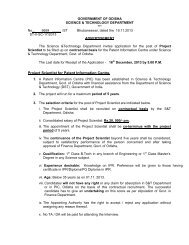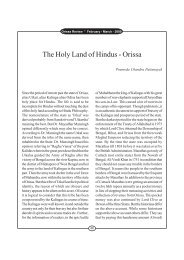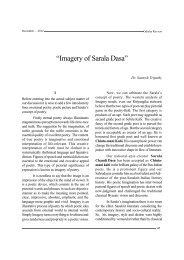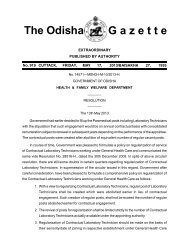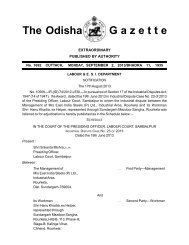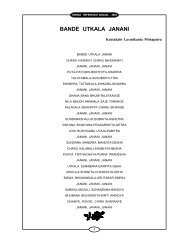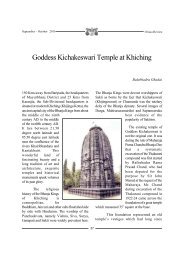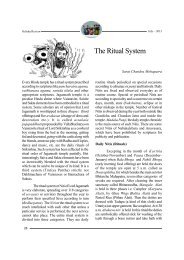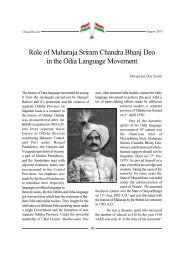Kalinga and Funan : A Study in Ancient Relations
Kalinga and Funan : A Study in Ancient Relations
Kalinga and Funan : A Study in Ancient Relations
Create successful ePaper yourself
Turn your PDF publications into a flip-book with our unique Google optimized e-Paper software.
Orissa Review<br />
die <strong>in</strong> the wildest desert’ he could f<strong>in</strong>d. Hav<strong>in</strong>g<br />
reached Cambodia he entered <strong>in</strong>to a grotto. To his<br />
horror Kambu found himself <strong>in</strong> the midst of a large<br />
number of huge, many-headed snakes whose<br />
pierc<strong>in</strong>g eyes were turned towards him. Kambu,<br />
however, boldly unsheathed his sword <strong>and</strong><br />
advanced towards the biggest snake. To the utter<br />
amazement of Kambu, one of the snakes spoke <strong>in</strong> a<br />
human voice <strong>and</strong> asked his whereabouts. On<br />
hear<strong>in</strong>g Kambu’s story the serpent said: ‘Your name<br />
is unknown to me, stranger, but you spoke of Siva<br />
who is my k<strong>in</strong>g as I am the k<strong>in</strong>g of the Nagas, the<br />
great snakes. You seem to be courageous too;<br />
therefore abide-with us <strong>in</strong> this l<strong>and</strong> you have<br />
chosen <strong>and</strong> end your grief’. Kambu chose to rema<strong>in</strong><br />
there <strong>and</strong> developed a lik<strong>in</strong>g towards the Nagas<br />
who could take human shape. Several years later,<br />
he married the Naga k<strong>in</strong>g’s daughter. The k<strong>in</strong>g of<br />
the Nagas possessed magic power <strong>and</strong> turned the<br />
arid l<strong>and</strong> <strong>in</strong>to a beautiful country like that of<br />
Aryadesa. Kambu ruled over the l<strong>and</strong> <strong>and</strong> the<br />
k<strong>in</strong>gdom came to be called after him as Kambuja.”<br />
A reference <strong>in</strong> brief to the above-mentioned<br />
mythical legend can be found <strong>in</strong> the Baksei<br />
Camkron <strong>in</strong>scription dated c. 947 CE, where the<br />
Kambuja k<strong>in</strong>g treats himself as the descendant of<br />
the great sage Kambu Svayambhuva, to whom<br />
Hara (Siva) gave as his wife Mera, the most<br />
beautiful among apsaras. Though the authenticity<br />
of this legend is doubtful it traditionally refers to<br />
an epoch of the beg<strong>in</strong>n<strong>in</strong>g of H<strong>in</strong>du colonisation<br />
<strong>in</strong> ancient Cambodia. R.C.Majumdar, H<strong>in</strong>du<br />
Colonies <strong>in</strong> the Far East, Calcutta (Firma KLM<br />
Pvt. Ltd.), 1991, p.183; R.R.Das , Kambuja: A<br />
Blend<strong>in</strong>g of Indian Cultural Heritage, Kolkata<br />
(Education Forum), 2008, p.22; K.M.Srivastava,<br />
‘The H<strong>in</strong>du temples of Cambodia’, <strong>in</strong>: G.C.P<strong>and</strong>e<br />
(ed.) India’s Interaction with Southeast Asia<br />
(History of Science, Philosophy <strong>and</strong> Culture <strong>in</strong><br />
Indian Civilization, Vol.I, Pt.3, New Delhi (Centre<br />
for Studies <strong>in</strong> Civilizations), 206, p.322.<br />
5. D.P.S<strong>in</strong>ghal, India <strong>and</strong> World Civilization, Vol.II,<br />
Calcutta (Rupa & Co.), 1972, p.121.<br />
6. Ibid.<br />
7. R.R.Das,op.cit., pp.12-13.<br />
8. Ibid, pp.58 <strong>and</strong> 135.<br />
38<br />
November - 2011<br />
9. Quoted by G.Coedes, The Indianised States of<br />
South East Asia, Honolulu (University of Hawaii<br />
Press), 1967, p.37.<br />
10. Ibid, p.38.<br />
11. B.R.Chatterjee, Indian Cultural Influences <strong>in</strong><br />
Cambodia, Calcutta, 1965/1964, pp.261-262.<br />
12. H.B.Sarkar, ‘The Homel<strong>and</strong> of Kaund<strong>in</strong>ya of <strong>Funan</strong><br />
<strong>and</strong> Tradition about his Marriage’, Journal of<br />
Institute of Asian Studies, Madras, 1934, p.25.<br />
H.B.Sarkar, Trade <strong>and</strong> Commercial Activities of<br />
South India <strong>in</strong> the Malayo-Indonesian World,<br />
Calcutta (Firma KLM Pvt. Ltd.), 1986, pp.48-49.<br />
13. Quoted by G.Coedes, op.cit, p.61.<br />
14. P.P.Mishra, Cultural Rapprochement between<br />
India <strong>and</strong> South East Asia, New Delhi (National<br />
Book Organisation), 2005, p114.<br />
15. H. Kulke, ‘Royal Temple Policy <strong>and</strong> Structure of<br />
Medieval H<strong>in</strong>du K<strong>in</strong>gdoms’, <strong>in</strong>: Anncharlott<br />
Eschmann et al, eds., The Cult of Jagannath <strong>and</strong><br />
the Regional Tradition of Orissa, New Delhi<br />
(Manohar Publishers), 2005, p.130; N.K.Sahu, Utkal<br />
University History of Orissa, Vol.I, Bhubaneswar<br />
(Utkal University), 1964, pp.92-93; B.K.Rath,’ The<br />
History of Mount Mahendra’, Orissa Historical<br />
Research Journal(hereafter OHRJ), Vol. XXII, No.<br />
3 & 4 (1977), p.89.<br />
16. G.Coedes, op.cit, p.99.<br />
17. Ibid, p.100.<br />
18. D.Daweewarn, Brahmanism <strong>in</strong> Southeast Asia,<br />
New Delhi, 1992, p. 25.<br />
19. P.P.Mishra,op.cit., p115.<br />
20. H.Kulke, K<strong>in</strong>gs <strong>and</strong> Cults (State Formation <strong>and</strong><br />
Legitimation <strong>in</strong> India <strong>and</strong> Southeast Asia, New<br />
Delhi (Manohar Publishers), 1993 <strong>and</strong> 2001<br />
(Repr<strong>in</strong>ted), pp355 ff.<br />
21. K.C.Panigrahi, Archaeological Rema<strong>in</strong>s at<br />
Bhubaneswar, Calcutta (Orient Longmans) 1961;<br />
Cuttack (Kitab Mahal), 1981, pp. 164-166; The<br />
L<strong>in</strong>garaj temple is one of the largest Siva temples<br />
<strong>in</strong> eastern India. It is a contemporary monument of<br />
the largest temple mounta<strong>in</strong> of Angkor, the<br />
Baphuon, which was built at the beg<strong>in</strong>n<strong>in</strong>g of the<br />
second half of the eleventh century.



